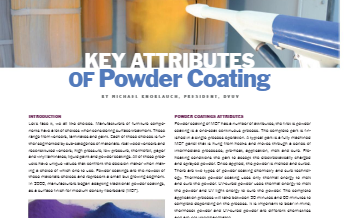Surface & Panel Magazine Q1 2013
Let’s face it, we all like choices. Manufacturers of furniture components have a lot of choices when considering surface treatment. These range from veneers, laminates and paint. Each of these choices is further segmented by sub-categories of materials: real wood veneers and reconstituted veneers; high pressure, low pressure, thermofoil, paper and vinyl laminates; liquid paint and powder coatings. All of these products have unique values that confront the decision maker when making a choice of which one to use. Powder coatings are the newest of these materials choices and represent a small but growing segment. In 2000, manufacturers began adapting traditional powder coatings, as a surface finish for medium density fiberboard (MDF).
POWDER COATINGS ATTRIBUTES
Powder coating of MDF has a number of attributes; the first is powder coating is a one-coat continuous process. The complete part is finished in a single process operation. A typical part is a fully machined MDF panel that is hung from hooks and moves through a series of intermediate processes; pre-heat, application, melt and cure. Preheating conditions the part to accept the electrostatically charged and sprayed powder. Once applied, the powder is melted and cured. There are two types of powder coating chemistry and cure technology. Thermoset powder coating uses only thermal energy to melt and cure the powder. UV-cured powder uses thermal energy to melt the powder and UV light energy to cure the powder. The complete application process will take between 20 minutes and 60 minutes to complete depending on the process. It is important to bear in mind; thermoset powder and UV-cured powder are different chemistries and are not interchangeable.
Color shapes the way we perceive and see the world. Color palette is the second attribute. Powder formulators offer a large assortment of stock colors, which are typically sold in 55-pound boxes. Many other colors have been formulated and are represented in the powder formulator’s library of standard colors. Powder formulators will also produce custom colors based upon various color standards: RAL, PMS, Pantone or other paint systems. In addition to pigmented colors, formulators create metallic, pearlescent, multi-component and special effect powder coatings.
Historically, durability and performance are what make powder coatings excellent coatings for metal products. The powder coatings used on MDF are very durable had have admirable performance properties. Durability is the third attribute of powder coating. All powder manufacturers publish performance specifications for their products. These specifications demonstrate surface properties, chemical resistance, and other physical properties. This specification data is often ASTM or NEMA test standards and can be compared to the results of other materials. Resin is the backbone of all powder coatings. Different resins have different performance characteristics and it is important to understand how to select the right coating based upon the resin. Typically, powder coatings used for MDF applications are made with polyester resins. Products that require more durability or other requirements can be made from urethane or hybrid resin systems.
The fourth benefit of powder coating is the efficiency of the process. There are two types of application systems: manual and automatic. Manual systems require operators with powder guns to apply the powder onto the parts as they pass by in the powder booth. Manual systems are ideal for low volume applications or where there is a wide variety of products being finished. Automatic systems are designed to finish long runs of the same part, eliminate operator fatigue and improve finish quality from part to part and run to run. Manual systems are less expensive to purchase, but automatic systems have lower total applied costs. Fast color change modules and powder reclaim systems increase system efficiency. Color changes can be reduced to minutes and powder reclaim systems increase transfer efficiency into the mid-90 percent range. Overall, a powder coating system that is correctly designed and efficiently run can have a first pass quality performance in the high 90 percent range.
Powder coatings have significant environmental advantages and benefits compared to other materials. According to Chemark Consulting Group, solvent-borne liquid coatings represent 75 to 80 percent of the wood coatings industry. Global pressure is increasing to reduce and even eliminate solvent-borne chemistries. Demand for non-solvent based coatings is increasing in response to legislation and regulation in the United States and Europe. Even China is putting pressure on firms that manufacture and use solvent-borne chemistries. Powder coatings are environmentally friendly; they do not contain any volatile organic compounds (VOCs) or hazardous air pollutants (HAPs). Powder application plants do not require any air quality monitoring or stack permits to build or operate. There are no requirements to report material usage to any government agency. A material spill requires only a broom or vacuum cleaner to clean up. Powder coatings do not contain any chemicals or volatiles that will harm employees or end users. They are easy to use and dispose. In fact, many users of powder coating have the powder waste recycled or reprocessed, keeping waste material out of the waste stream.
CONCLUSION
Choices are an indication of a vibrant marketplace full of great opportunities. Over the years, much progress in the finishing and coatings market has been made to ensure consumers have a variety of choices. It is important to understand the value proposition of each choice and fairly weigh the benefits and constraints of each. Powder coating technology is a great finishing and coating option that manufacturers of furniture can use effectively and well.
JUN

